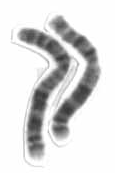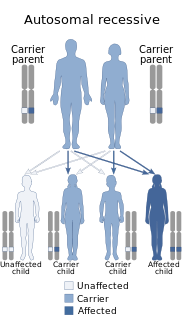 W
W2p15-16.1 microdeletion is an extremely rare genetic disorder caused by a small deletion in the short arm of human chromosome 2. First described in two patients in 2007, by 2013 only 21 people have been reported as having the disorder in the medical literature.
 W
WAchard syndrome is a syndrome consisting of arachnodactyly, receding lower jaw, and joint laxity limited to the hands and feet. Hypermobility and subluxations of the joints, increased lateral excursion of the patellas and other findings reflect the increased ligament laxity. It is clinically similar to Marfan syndrome.
 W
WAckerman syndrome is a familial syndrome of fused molar roots with a single canal (taurodontism), hypotrichosis, full upper lip without a cupid's bow, thickened and wide philtrum, and occasional juvenile glaucoma. It was described by James L. Ackerman, A. Leon Ackerman, and A. Bernard Ackerman.
 W
WAcrocallosal syndrome is a rare autosomal recessive syndrome characterized by corpus callosum agenesis, polydactyly, multiple dysmorphic features, motor and intellectual disabilities, and other symptoms. The syndrome was first described by Albert Schinzel in 1979.
 W
WAcropectoral syndrome is an autosomal dominant skeletal dysplasia syndrome affecting the hands, feet, sternum, and lumbosacral spine. A recently proposed candidate gene for preaxial polydactyly is LMBR1, encoding a novel transmembrane receptor, which may be an upstream regulator of SHH. The LMBR1 gene is on human chromosome 7q36.
 W
WCardiofaciocutaneous (CFC) syndrome is an extremely rare genetic disorder.
 W
WConstriction ring syndrome (CRS) is a congenital disorder with unknown cause. Because of the unknown cause there are many different, and sometimes incorrect names. It is a malformation due to intrauterine bands or rings that give deep grooves in, most commonly, distal extremities like fingers and toes. In rare cases the constriction ring can form around other parts of the fetus and cause amputation or even intrauterine death. The anatomy proximal to the site of constriction is developmentally normal. CRS can be associated with other malformations with club foot being most common. (see also Types and Classification). The precise configuration of the bands, lymphedema, and character of the amputations are not predictable and vary with each individual patient. Also more than one extremity is usually affected, and it is rare for only one ring to present as an isolated malformation with no other manifestation of this syndrome.
 W
WCorneodermatosseous syndrome is an autosomal dominant condition with onset in infancy, characterized by corneal dystrophy, photophobia, diffuse palmoplantar keratoderma, distal onycholysis, skeletal abnormalities, with brachydactyly, short stature, and medullary narrowing of digits.
 W
WD-glycerate dehydrogenase deficiency or PHGDH is a rare autosomal metabolic disease where the young patient is unable to produce an enzyme necessary to convert 3-phosphoglycerate into 3-phosphohydroxypyruvate, which is the only way for humans to synthesize serine.This disorder is called Neu-Laxova syndrome in neonates.
 W
WDiploid-triploid mosaicism (DTM) is a chromosome disorder. Individuals with diploid-triploid syndrome have some cells with three copies of each chromosome for a total of 69 chromosomes and some cells with the usual 2 copies of each chromosome for a total of 46 chromosomes.
 W
WEctrodactyly–ectodermal dysplasia–cleft syndrome, or EEC, and also referred to as EEC syndrome and split hand–split foot–ectodermal dysplasia–cleft syndrome is a rare form of ectodermal dysplasia, an autosomal dominant disorder inherited as a genetic trait. EEC is characterized by the triad of ectrodactyly, ectodermal dysplasia, and facial clefts. Other features noted in association with EEC include vesicoureteral reflux, recurrent urinary tract infections, obstruction of the nasolacrimal duct, decreased pigmentation of the hair and skin, missing or abnormal teeth, enamel hypoplasia, absent punctae in the lower eyelids, photophobia, occasional cognitive impairment and kidney anomalies, and conductive hearing loss.
 W
WEllis–van Creveld syndrome is a rare genetic disorder of the skeletal dysplasia type.
 W
WGreig cephalopolysyndactyly syndrome is a disorder that affects development of the limbs, head, and face. The features of this syndrome are highly variable, ranging from very mild to severe. People with this condition typically have one or more extra fingers or toes (polydactyly) or an abnormally wide thumb or big toe (hallux).
 W
WHolt–Oram syndrome is an autosomal dominant disorder that affects bones in the arms and hands and often causes heart problems. The syndrome may include an absent radial bone in the forearm, an atrial septal defect in the heart, or heart block. It affects approximately 1 in 100,000 people.
 W
WJoubert syndrome is a rare autosomal recessive genetic disorder that affects the cerebellum, an area of the brain that controls balance and coordination.
 W
WMcKusick–Kaufman syndrome is a genetic condition associated with MKKS.
 W
WMyhre syndrome is a rare genetic disorder inherited in an autosomal dominant fashion. It is caused by mutation in SMAD4 gene.
 W
WNager acrofacial dysostosis, also known as Nager syndrome, is a genetic disorder which displays several or all of the following characteristics: underdevelopment of the cheek and jaw area, down-sloping of the opening of the eyes, lack or absence of the lower eyelashes, kidney or stomach reflux, hammer toes, shortened soft palate, lack of development of the internal and external ear, possible cleft palate, underdevelopment or absence of the thumb, hearing loss and shortened forearms, as well as poor movement in the elbow, and may be characterized by accessory tragi. Occasionally, affected individuals develop vertebral anomalies such as scoliosis.
 W
WPatau syndrome is a syndrome caused by a chromosomal abnormality, in which some or all of the cells of the body contain extra genetic material from chromosome 13. The extra genetic material disrupts normal development, causing multiple and complex organ defects.
 W
WPfeiffer syndrome is a rare genetic disorder characterized by the premature fusion of certain bones of the skull (craniosynostosis) which affects the shape of the head and face. In addition, the syndrome includes abnormalities of the hands and feet.
 W
WPoland syndrome is a birth defect characterized by an underdeveloped chest muscle and short webbed fingers on one side of the body. Short ribs, less fat, and breast and nipple abnormalities may also occur on that side. Typically the right side is involved. People generally have normal movement and health.
 W
WRubinstein–Taybi syndrome (RTS), is a condition characterized by short stature, moderate to severe learning difficulties, distinctive facial features, and broad thumbs and first toes. Other features of the disorder vary among affected individuals. These characteristics are caused by a mutation or deletion in the CREBBP and/or EP300 gene located on chromosome 16.
 W
WSilver–Russell syndrome (SRS), also called Silver–Russell dwarfism, is a rare congenital growth disorder. In the United States it is usually referred to as Russell–Silver syndrome (RSS), and Silver–Russell syndrome elsewhere. It is one of 200 types of dwarfism and one of five types of primordial dwarfism.
 W
WThe VACTERL association refers to a recognized group of birth defects which tend to co-occur. Note that this pattern is a recognized association, as opposed to a syndrome, because there is no known pathogenetic cause to explain the grouped incidence.
 W
WWallis–Zieff–Goldblatt syndrome is a rare condition characterized by inherited skeletal disorders manifested mainly as rhizomelic short stature and lateral clavicular defects. It is also known as Cleidorhizomelic syndrome.